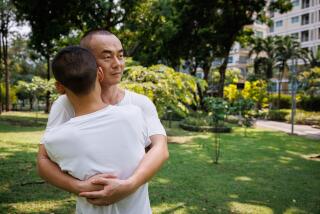A Different Breed of Backpacker Treks to Thailand
- Share via
BANGKOK, Thailand — Where have all the gritty backpackers gone, those shoestring vagabonds from the West with soiled, baggy garb who considered body odor the badge of a true traveler.
On Bangkok’s Khao San Road, one of the world’s densest concentrations of young travelers, the scruffy backpacker seems on the road to extinction, the stuff of nostalgia and Hollywood movies.
The youthful brigades still struggle under overstuffed backpacks, clutch their Lonely Planet guides, scour for bargains and fuel up on muesli, banana pancakes and hummus. But they’re different.
“The image of the backpacker is of someone laying around on a beach getting stoned, and a small percentage are like that,” says Eleanor Land, a neatly dressed 18-year-old from Edinburgh, Scotland. “But most travel to learn as much about a country as they can.”
Ordering a 10-baht (24-cent) bowl of noodles from a street vendor, she’s on her “gap year,” the time-out young Britons take between high school and university. Land spent four months teaching slum children in India and is traveling in Southeast Asia with friends for two months.
John Hughes, a British expatriate who runs a Web site about Khao San Road, says young people taking breaks in schooling and those seeking temporary employment and learning opportunities abroad have largely replaced the travelers of old who wandered as far and as long as their money would take them. And there are some older ones who come back drawn by fond memories of their younger backpacking days.
“It seems to me that a lot of backpackers have plastic in their back pockets whereas they didn’t before,” says Hughes, who first encountered Khao San Road 15 years ago. “They’re better organized and getting more packaged.”
Khao San has likewise undergone dramatic change. The 300-yard strip and surrounding alleys, near the Grand Palace and other historic sights, have mushroomed from a few wooden, family-run guesthouses in the early 1980s into a thriving tourism area.
“Khao San Road -- anything you can ever want,” says Scott Robinson, quoting a line from “The Beach,” a novel turned into a Hollywood movie that boosted the popularity of the road and Thailand’s backpacking culture.
While two older Thai women twist his hair into dreadlocks, the 21-year-old Robinson talks about his upcoming eight months of travel, a liberating pause from studies and a love affair back in Sydney, Australia. Meanwhile, he’s experiencing Khao San Road and staying at a guesthouse for 150 baht a night, or about $3.50. “You can sometimes get it for 90 baht.”
But the area now also features several upscale hotels and trendy night spots, the latter attracting well-heeled Thais who once shunned the neighborhood as a ghetto for uncouth farangs (foreigners).
Travelers can still get their bodies tattooed and pierced, eat for rock-bottom prices and pick up a fake “International Press Card” or “British Columbia Driving License.” But Khao San has sprouted shopping arcades, American chain convenience stores, tailors and plenty of ATMs.
As testimony to backpacker spending power, rents in the area now equal those along Silom Road, Bangkok’s “Wall Street,” says Nopporn Bhuttan, a member of the Khao San Road Business Assn.
Thai tourism officials who once paid scant attention to the district have realized there’s big baht in backpacking. The Tourism Authority of Thailand says 1.5 million under-25 visitors came to Thailand last year, representing more than 15% of total arrivals. Mostly students, they stay longer and leave more of their money with local businesses than mainline tourists, whose spending at international hotels and travel agencies often doesn’t go in Thai coffers.
Two other trends warm Thai hearts. Whereas most backpackers in earlier days were Westerners, followed later by the Japanese, Khao San Road now attracts Koreans, Taiwanese and Hong Kong citizens. Vast potential is seen in China and India.
Thailand has grown into a regional “backpack headquarters.” Young tourists crowd dozens of Khao San travel agencies to buy cheap air tickets to Laos, Cambodia, Vietnam and elsewhere. Many return from those less-developed destinations to rest, recuperate and replenish supplies before venturing out again.
Some critics view backpackers, past and present, as despoilers of cultural and natural environments. Others lament that the serendipity of life on the road has vanished, with most of today’s backpackers sticking to themselves along well-worn paths.
Nopporn, whose family has run businesses on the road for 30 years, is of two minds. “In the old days, there was a more family, more friendly, feeling,” he says. “You knew the customers. Now it’s more business. It’s both good and bad.”
More to Read
Sign up for The Wild
We’ll help you find the best places to hike, bike and run, as well as the perfect silent spots for meditation and yoga.
You may occasionally receive promotional content from the Los Angeles Times.






